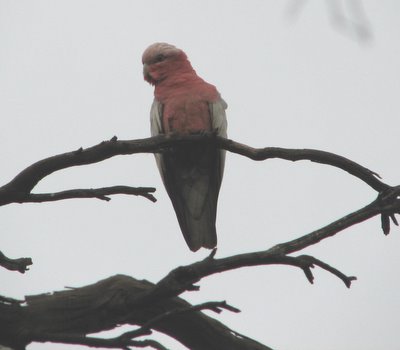Possible Galah nesting attempt
The beautiful Galah is a very common bird around where we live in Murray Bridge, South Australia. Flocks of several hundred are a common sight in the summer months.
Over the last few weeks two Galahs have been investigating a hollow in an old growth mallee tree near our house. This hollow is in clear view from where we often have meals on our new back veranda. The tree is about 30 metres away.
I hesitate to call them a “pair” because I haven’t actually seen them mating. I have strong reasons for calling them as such because one is a male and the other is a female and they are displaying typical nesting behaviour. (The female has a red eye, the male a dark brown eye.)
This pair has been hanging around this hollow for several hours every day now for many weeks. Both often go into the hollow to check it out. I can’t tell if they are actually enlarging it or not. They allow us to get quite close to the tree without flying off.
Then last week while we were having lunch they started breaking small leafy twigs off the tree and taking them into the hollow to line their nest. Seems fairly conclusive to me.
The only downside it that we will have to put up with some very noisy little neighbours later in the year. Baby Galahs can be very demanding and very noisy.
I’ve taken quite a few photos. Below is a selection of the best of them. Click on the photo to enlarge the image.
Galahs nesting
Over the last few weeks several Galahs have been hanging around a hollow in one of our mallee trees near our house. This is the largest tree on our property and is probably well over a hundred years old-maybe several hundred. Only mature age mallee trees have trunks the size of this one. And only mature mallee trees develop branches large enough to create hollows.
Over recent years this hollow hosted a wild bee colony, but that seems to have moved on. Over the last two to three years Galahs have investigated this hollow on many occasions but none has nested in it. One pair even diligently went about enlarging the hollow but with no nesting taking place.
I can’t be sure whether this is the same pair or a new pair trying it on for size. They certainly seem very interested and hang around there off and on for several hours every day. They even chase off other interested tenants, so they must be quite serious about it.
I’ll keep you posted on any developments on the home front.
Galahs on Guard

This morning while out in the garden I saw about eight Galahs fly in quietly and settle on the tall mallee tree near the house. I observed them watching me carefully as I tried not to look too conspicuous as I casually went inside to fetch the camera. they were still there when I came out but were very cautious.
I managed to get a few shots of them before they flew off squawking in their usual manner. Perhaps they didn’t like me pointing something up at them. Maybe they were heading off to join the flock I heard calling in the distance. The flock seemed to be quite large; sometimes they can reach into the hundreds.
The shots I managed are not very good photographs. The sky was overcast and the light conditions very poor. Somewhere in my collection of slides I have a magnificent photograph of a pair of Galahs sitting on the remnant of a tree sticking out of the water in one of the lakes at Hattah-Kulkyne National Park in Victoria. The photo was taken with the last rays of sunlight lighting up the rose coloured feathers. I must find that slide, scan it and post it here.
It is a magnificent sight to see a flock of two to three hundred Galahs all gliding and wheeling through the air in unison, the setting sun lighting up their breast feathers like so many rose coloured beacons flaming against the deep blue Australian sky.
Less attractive are the sneaky groups of half a dozen or so that slip under our radar in the early morning light and proceed to demolish the crop on our almond trees weeks before they are ready to pick. Or the brazen individuals that sit atop the pear trees, nibbling around the stem of each piece of fruit, again, only weeks before they are ripe.
Updated Nov 2013.







